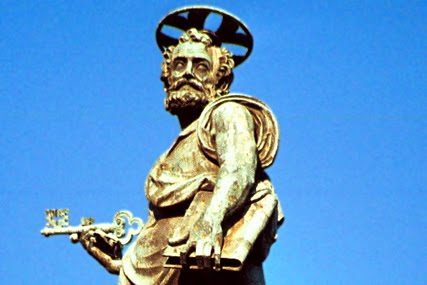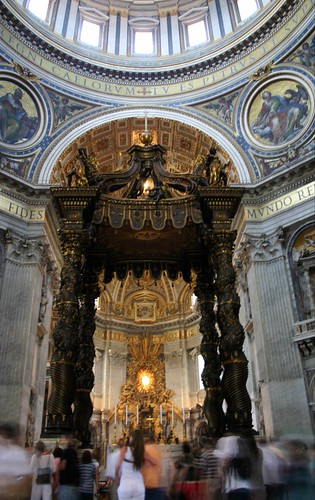Cards In This Set
| Front | Back |
 ? |
Bramante,
Tempietto (San Pietro in Montorio),
1503
a. Small commemorative martyrium
b.
Originally
patronized by King Ferdinand and Queen Isabella of Spain.
c.
Considered
a masterpiece of High Renaissance architecture
d.
one of
the most harmonious buildings of the Renaissance
e. Almost piece of sculpture, little architectonic use
f. Much of Brunelleschi's style
g.
Perfectly
proportioned, Tuscan columns, Doric entablature, dome
|
 ? |
Perugino,
Delivery of the Keys to St. Peter,
1480-81
a. Inspired by Andrea
del Verrocchio
i. active drapery, massive complexity, and
the figures, with beautiful features, long
flowing hair, elegant demeanour, and refinement
b.
poses
of the actors fall into a small number of basic attitudes that are consistently
repeated, usually in reverse from one side to the other, signifying the use of
the same cartoon
c. Sense of infinite world that stretches across horizon is stronger than other works of contemporaries, d. Feathery trees against
the cloud-filled sky with the bluish-gray hills in the distance represent a
solution that later painters would find instructive, especially Raphael.
|
 ? |
Michelangelo,
Sistine Ceiling, 1508-1512
a. subject
matter-humanity's need for Salvation through Jesus
b.
main
components of the design are nine scenes from the Book
of Genesis
c.
express
the specifically Renaissance thinking that sought to reconcile Christian
theology with the philosophy of Renaissance Humanism.
d.
fictive
architecture, the muscular anatomy, the foreshortening, the dynamic motion, the
luminous colouration, the haunting expressions of the figures in the lunettes, the abundance of putti
|
|
? |
1.
Michelangelo,
Campidoglio, 1536-64; piazza and
Marcus Aurelius equestrian statue
a.
commissioned
by Pope Paul III, who
wanted symbol of the new Rome to impress Charles V
b.
The
three remodelled palazzi enclose a harmonious trapezoidal space, approached by
the ramped staircase called the "Cordonata".
c.
no
"perfect" forms would work within the dimension of the plaza, his
apparent oval in the paving is actually egg-shaped
d.
statue
provided a center and a focus
ii. Michelangelo provided pedestal. sculpture held in regard because thought to depict Constantine
e.
buildings
defined the space, and it is this space as much as the buildings. It is a giant
outdoor room, a plaza enclosed and protected but open to the sky and accessible
through five symmetrical openings
|
 ? |
1. Raphael, Parnassus, Stanza della Segnatura, 1511
a.
Parnassus
represents poetry, ancient and Renaissance poets are centered around Apollo and nine muses
b.
Two of the muses in the frescoe are reminscent of
Michaelangelo's Creation of Adam, Euterpe and the named
(scroll) Sappho
c.
Homer inspired by Laocoon
|
 ? |
1.
Raphael, The School of Athens Stanza della
Segnatura, 1510-1511
a.
Aristotle-the central figure
b.
Raphael invented system of iconography to allude to various figures for whom there
were no traditional visual types
c.
Plato
points up; Artistotle points down
d.
Raphael's
artistry in orchestrating a beautiful space, continuous with that of viewers in
the Stanza, in which a great variety of human figures, each one expressing
"mental states by physical actions", interact, and are grouped in a
"polyphony" unlike anything in earlier art
|
 ? |
1.
Laocöon, marble, Roman copy first cent CE after Hellenistic
original; rediscovered 1509; Vatican Museums
a.
Trojan priest Laocoön and his sons strangled by serpents
b.
Michelangelo impressed by massive scale of the work and its sensuous Hellenistic aesthetic, particularly its depiction of the male
figures
c.
paradox
of admiring beauty while seeing a scene of death and failure
d.
Could not realistically depict physical
suffering of victims, as this would be too painful. Express suffering while retaining beauty.
|
 ? |
1.
Belvedere Torso (rediscovered 1490), Vatican Museums
a. believed that Apollonius copied a 2nd-century original
b.
dynamic
pose of the torso influenced the development of the energetic figure style of
Michelangelo
|
 ? |
1.
Giovanni
Maggi, Idealized Roman Street Plan,
1588; from reign of Sixtus V
a.
shows Rome
can be the site of urban changes
b. Mussolini and popes changed city.
c. shows a 16th century rendition of how Rome can be envisioned if
you plan it around churches rather than ancient monuments.
d. obelisks are omnipresent: symbol of power, of imperial rule that
goes back to the ancient Romans and goes on until Mussolini e. all of them are today capped by crosses or papal insignias. |
 ? |
1.
St.
Peter atop Column of Trajan, 1588-89, bronze
a.
active
striding pose, the figure turning on axis as he extends his keys into space.
b.
exaggerated
facial features, perhaps necessitated by the great height of the figure from
the ground, recall those of earlier papal images.
|
 ? |
1.
Tommaso Laureti, Triumph of Christian Religion over Paganism, fresco, Vatican Museum, 1582-85; finished
under Sixtus V
a.
refers
to the destruction of the pagan idols and their replacement with the image of
Christ, ordered by Constatntine throughout the empire
|
 ? |
1.
Bernini,
Baldacchino, St. Peter’s, 1623-34
a.
large Baroque sculpted bronze canopy, over high altar of SP, at centre of crossing and
directly under dome
b.
first
of Bernini's works to combine sculpture and architecture and represents an
important development in Baroque church interior design and furnishing
c.
is
a very large structure and forms a visual mediation between the enormous scale
of the building and the human scale of the people officiating at the religious
ceremonies at the papal altar beneath its canopy
|
 ? |
1.
Bernini,
Fountain of the Four Rivers, 1651
a. dynamic fusion of architecture and sculpture was revolutionary
b. base of fountain-basin from centre of which travertine rocks rise
to support four river gods and above them, an ancien tEgyptian obelisk surmounted with Pamphili family emblem of a dove
with an olive twig
|
 ? |
1.
Poussin,
The Rape of the Sabine Women 1,
1633-34
a.
Romulus
raised cloak as prearranged signal for the warriors to seize the women.
b.
The
mother, her babies, and an old woman in the foreground were captured
accidentally in the turmoil.
c.
yellow
armor worn by man at the right is modeled after a Roman "lorica,"
which was made of leather and reproduced the anatomy of the male torso.
|
 ? |
1.
Piranesi,
Roman Antiquities (Antichità Romane), 1756
a.
intended
as a substantial record of ancient Rome with plans, sections, and, above all,
emphasis on construction, features which make it a turning-point in the history
of Roman archaeology
b.
principal
intention was the application of archaeology to contemporary design
|



